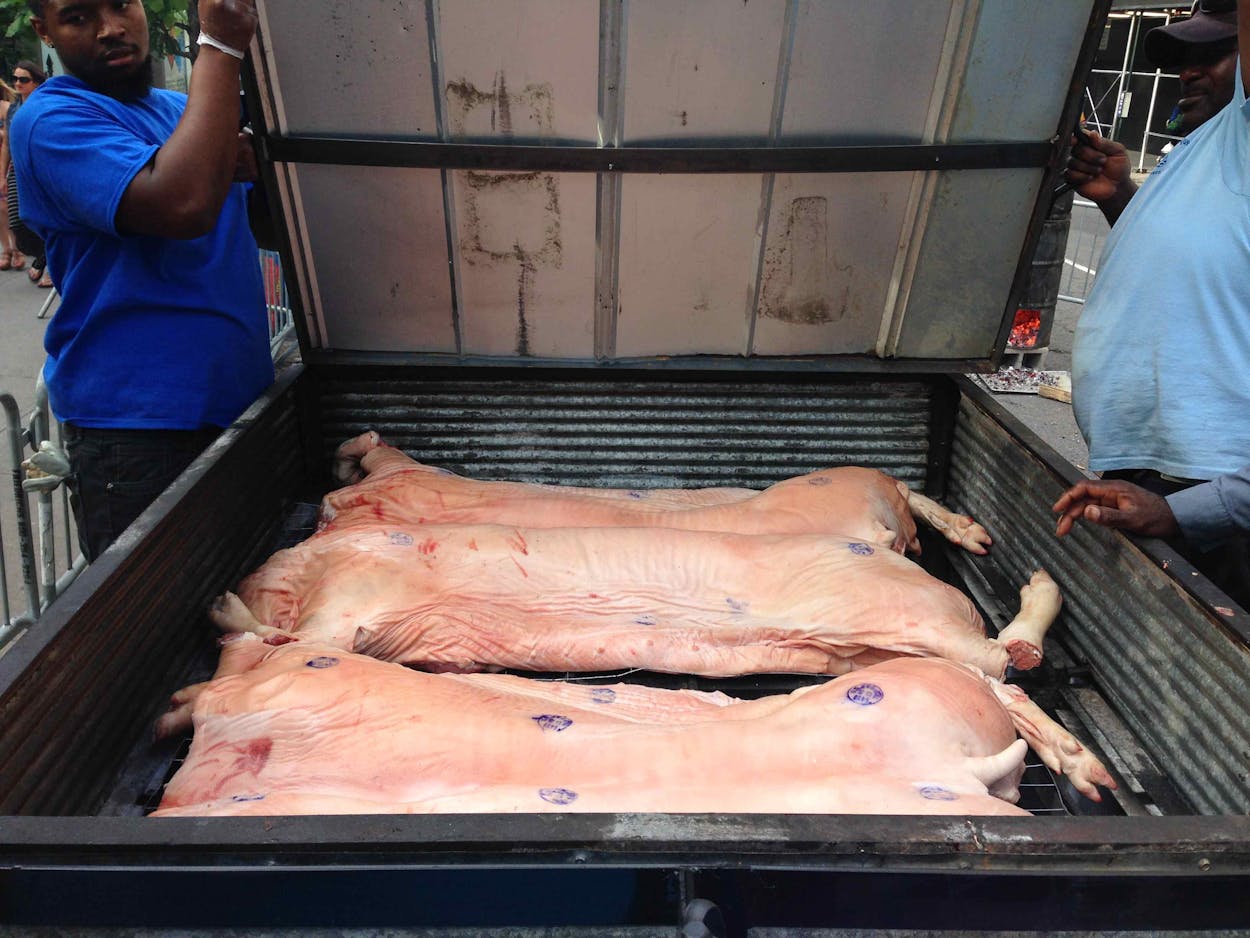During the nineteenth century public barbecues in Texas, you were likely to find a whole calf, goat, or lamb roasting for the crowd. But it was more likely that you’d find a whole hog. Hogs were prevalent in the eastern part of the state, which made them easier to come by, and if there were fewer mouths to feed, it made more sense to cook a hog than an entire steer or ox. At the time, the pits were generally manned by slaves who had either borrowed or brought the cooking methods of the southeast with them. Basically, they’d dig a trench, burn wood down to coals in the hole, and roast a whole animal directly over those coals. That cooking method isn’t found very often in Texas anymore, and whole hog cooking is a bit of a novelty here. But in the Carolinas, those generations-old barbecue methods are still employed all over the eastern part of either state.
Last weekend I had a unique opportunity to watch three of the most respected whole hog cookers in the country – Ed Mitchell, Samuel Jones, and Rodney Scott – practice their craft. In a single square block in New York City, no less. They had all come together, along with fourteen other pitmasters, to the annual Big Apple BBQ Block Party. There were some Texans in attendance, but I wasn’t seeking out any brisket revelations in the streets of Manhattan. I wanted to know the ins and outs of this challenging menu item of whole hog. How do you get the thin belly done at the same time as the thick hams; what’s the secret to getting those crispy pork skins; and why don’t they make it easy on themselves and just cook pork shoulders?

The three versions of Carolina whole hog at the Big Apple BBQ were all incredible, but just like all the variations in Texas brisket, these Carolina pitmasters have significant differences in their preparation. One thing they have in common is starting the hog the night it’s intended to be consumed. For Ed Mitchell that involves lighting a very large metal tubful of charcoal, both lump and briquettes. The all-wood purists see charcoal as a shortcut, maybe even cheating, but Mitchell uses it for its heat intensity. “I don’t do the low and slow concept. I do hot and fast.” He starts out the hog with two solid hours at 450 degrees, then he lets it taper down to 250 to finish off the cook. His hogs get done a bit faster than most, but it’s hard to argue with a man known to some as the “pope of barbecue.”
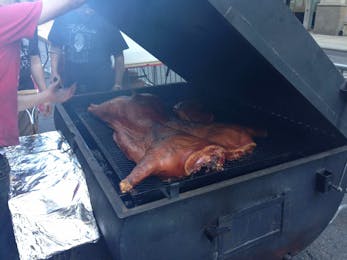
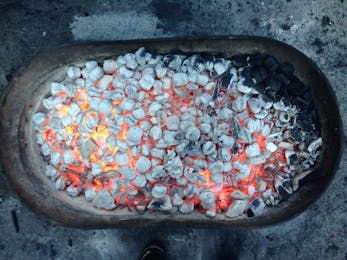
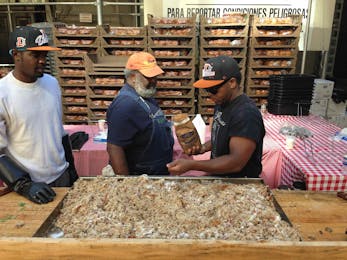
As for seasoning, Mitchell doesn’t get carried away. “They go on naked.” All of the seasoning, even the salt, is added to the finished meat once it’s chopped. The now empty pork skins go back to the cookers to get crisped over the fire. The skins are then chopped right into the meat along with the sugar, vinegar, salt, pepper, and hot sauce. As I chomped on a sandwich from Mitchell, I thought I had broken a tooth, but it was just an extra crunchy bit of pork skin. The charcoal flavor is certainly prevalent in the finely chopped pork. It’s not overwhelming, but rather than the background note provided by hickory coals, the charcoal asserts itself into every bite. Coupled with the more soothing sweetness from the sugar, it makes for pork that I’d rather eat on a fork than on a bun.
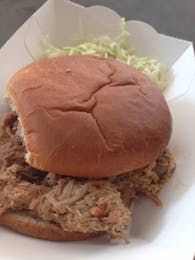
Ed Mitchell’s method: Charcoal fuel, hot and fast, no seasoning on raw hogs, pork chopped fine with skin, meat seasoned during chopping.
Hickory smoke wafted over the intersection of 26th and Madison on Friday night as the Skylight Inn crew from Ayden, North Carolina, was feeding hickory into their slender burn barrels. The heat was intense. An empty plastic bag driven by the breeze shriveled on contact with the red hot chimney. The coals that fell through the metal slats to the bottom are what is used to fuel the pits. They have eight custom-built steel pits mounted to a trailer, and each pit gets its own hog. (They would all be eaten the following day.)
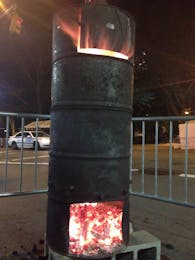
Samuel Jones is the traveling face of Skylight Inn and the grandson of its late founder. He runs the show here at the Big Apple BBQ, but it’s Jeff Jones that I found peering into the pit at the underside of the hog on Saturday morning, checking to see if the skin was adequately browned. Jeff is actually Samuel’s cousin, but everyone calls him Uncle Jeff. He tells me that for the 11:00 a.m. opening time, he has to get the hogs on the pits around 6:00 the night before. The skin side is salted heavily, but not for seasoning purposes. “That’s just to dry out the skin and get it crispy.” How does he know when the hogs are done? “I’ve done it long enough that I can just look at it to see how it has shrunk up,” he said. “I do the look, listen, feel thing.” For Jeff, it’s all about patience, and he’s happy to cook them slow.
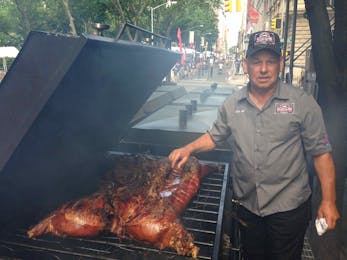
When the hogs are done, they are quartered and then sent to the chopping table. Meat isn’t separated from skin, but the two are chopped together by the gregarious Mike Parrett. He goes by “Chopper” and has a custom necklace with crossed cleavers that sparkles as he twirls two very large custom chopping cleavers. Once he’s done chopping there is a flurry of spices added to the mix: streams of salt, black pepper, Texas Pete hot sauce, and vinegar are applied to the meat, with restraint. Samuel is adamant that the sauce or seasoning should simply enhance the natural flavors of the pork. He notes that many North Carolina joints who don’t cook their hogs with wood try to enhance the flavor with more and more sauce. “You can’t make chicken salad out of chicken s— no matter how much mayo you use.” Samuel has more one-liners than I could keep up with, but as he hands me a golden disc of crispy skin he recites the Skylight Inn version of John 3:16. “For God so loved the world that he gave us pork skins.”
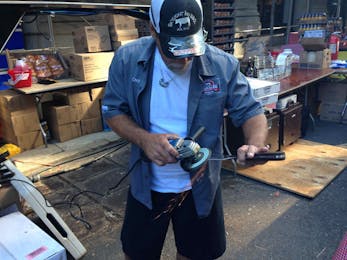

Because these skins come straight from the cooked hog rather than being further crisped, there is a thin layer of nearly liquified fat on the inner surface. The first bite was like communion. I closed my eyes to savor this rarified cracklin’ and contemplate its variation in texture. A communion wafer has never tasted so sinful. It’s almost a shame they chop these into the meat, but it does provide that nice hint of smokiness.
Samuel then reaches under the ribs of a freshly finished hog to grab a tassle of what he calls “pork spaghetti.” The long strands of belly meat are enrobed in melted fat and nearly melt on my tongue. Several layers of protein on either side hinder any smoke from getting to this cut, but it’s hard to remember a better bite of unadulterated hog.
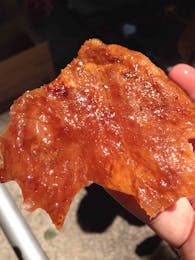
Samuel/Jeff Jones method: Wood fuel, low and slow, salts the skin side of the raw hogs, pork chopped fine with skin, meat seasoned during chopping.
If the Jones boys paint their hogs with a minimalist’s brush, Rodney Scott is the Jackson Pollock of whole hog. The pigs go through a similar routine of low-and-slow, skin-side-up cooking over direct heat for twelve hours, but once it’s been flipped over is when Rodney really gets to work. He quickly gets into the splayed hog with the end of a long metal spoon to to allow the deluge of flavor that coming to get deep into the meat. He’s got to be careful not to puncture the skin. The last thing he wants is to release a mess of hog grease (a.k.a. “pig napalm”) into the fire below. Once the tenderizing is done, he spreads on table salt and a dry rub that he premixes into plastic bags, partly to keep the ingredients under wraps. Now it’s time for the mop.

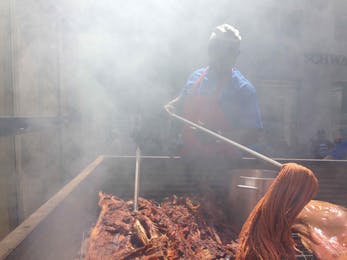
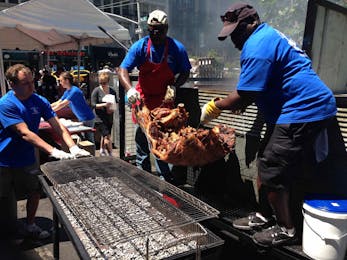
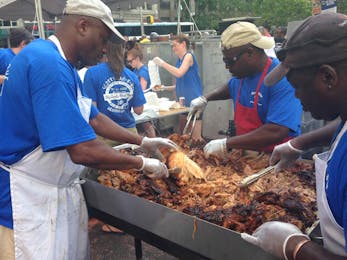
A brand new white cotton mop is unwrapped and dipped into a bucket full of rusty colored liquid. There’s a vinegar perfume and my eyelids tingle from the red pepper in the air. Rodney Scott liberally applies his signature mop sauce, but what’s in it? “Vinegar, pepper, and love.” Rivulets of hot liquid seep into every inch of the carcass. This is the first sign that there’s something different about how this South Carolina boys does things. The other clue is when the hog is taken off the heat. Instead of chopping the meat finely, it is separated from the bones and pulled into larger chunks and intact strands. The skin acts like a giant preparation platter until the pork has all been pulled, at which point the skin is cut down into chunks served alongside the meat. This is pork and skin meant to be eaten with your hands rather than a fork or between two pieces of bread.
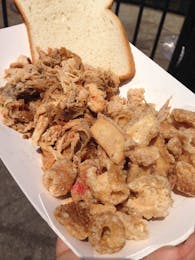
Rodney Scott’s method: Wood fuel, low and slow, no seasoning on the raw hogs, pork rustically pulled with skin served separately, meat seasoned with dry rub and mop during cooking.
But the question remained: why go to all this trouble? Why not just cook shoulders? It’s about the variation in flavor, color, texture, and moisture from one end of the hog to the other. Mixing the hams and shoulders with the fatty belly and the lean loin meat create a product with more interest than any single cut. “Whole hog just has a whole different flavor profile,” says Samuel Jones. When I press him for a deeper reason he stops me short. ” I could sit here and spin a yarn, but my family has just always done it this way and we’re gonna keep doing it this way.” Hallelujah.
- More About:
- Black BBQ


